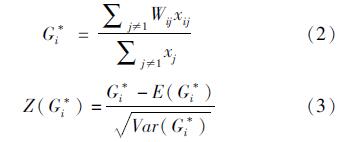2.1 研究区域与数据来源
(1)研究区域概况。皖北地区位于安徽省北部,地处皖苏鲁豫四省交汇区,地势平坦,以平原地形为主,行政区划范围包括安徽省淮河沿岸及以北的6个地级市,包括宿州市、淮北市、亳州市、阜阳市、蚌埠市、淮南市。皖北地区总面积约为4.278万平方公里,耕地面积约2.711万平方公里,耕地占比63.371%; 2019年末城镇常住人口1 417.724万人,乡村常住人口1 421.725万人,城镇化率为49.930%; 第一产业产值1 313.371亿元,第二、三产业产值9 550.656亿元。皖北地区是乡村人口占比大、城乡经济差距较大的传统农业发展区,对研究城乡融合发展的问题具有典型意义(图1)。
(2)数据来源与处理。数据来源于《安徽省统计年鉴》《安徽省建设统计年鉴》以及各市统计年鉴、统计公报和邮政业发展公报等。对于部分缺失的数据,采用均值填补法对缺失项进行填补。
2.2 研究设计
(1)研究框架。要素流动理论是在吸收早期西方经济学的资源禀赋理论、比较优势理论以及劳动价值论的认知基础之上形成的,主要指生产要素在地域空间的位移现象,表现为生产要素在地域空间上优化配置[12]。通过城乡要素双向流动,打破因城乡要素单向流动导致的城乡二元发展格局,实现城市与乡村之间要素双向流动与优势互补,促使各要素在城市与乡村之间合理配置,优化城市与乡村地域的空间、人口、经济、社会、生态结构,推动新型城镇化质量提升与城乡融合发展(图2)。
(2)研究方法。研究基于要素流动视角下城乡融合发展机制构建城乡融合发展的指标体系与评价模型,继而运用空间自相关等方法揭示城乡融合发展时空演变特征,最后运用地理加权回归模型探析城乡融合发展主要影响因素的作用强度。
①城乡融合发展评价指标选取与权重赋值。基于前述要素流动与城乡融合发展的互动机制,从城乡系统的人口、土地、社会服务、经济及生态等要素配置视角,选择人口流动、空间配置、社会服务、经济发展、生态环境等五个方面作为城乡融合发展评价的准则层。继而基于数据的科学性、可获取性、系统性等原则,参考既有的相关研究成果[13-16],运用文献指标借鉴、频度统计法等方法,最终选取城乡融合发展评价指标,包括人口城镇化水平、城乡劳动力流动、城乡人口迁移率、城乡人口密度比、土地城镇化水平、城乡土地配置、城乡医疗水平度、城乡教育发展度、城乡物流业务量、城乡居民用电量比、城乡人均可支配收入比、产业产值比、城乡消费品零售总额比、城乡资金流动、人均GDP、森林覆盖率、单位GDP能耗等17个指标。为避免量纲、数量级以及正负指标的差异,对城乡融合发展指标进行无量纲化处理,运用熵值法计算出各指标权重,最终确定城乡融合发展水平测度指标(表1)。
②空间自相关模型。地理学第一定律强调事物间相互关联性,研究空间中某个位置的观察值与其相邻位置是否存在相关性及相关程度的一种空间数据分析方法[17]21-22。本文运用空间自相关模型揭示城乡融合发展的空间特征,以全局Moran's I指数测度城乡融合发展整体空间关联[18],计算公式如下:

式中,n为空间单元数; xi和xj为样本i和j的观测值; x^-是全样本均值; Wij是空间权重矩阵,即当空间单元i和j相邻时Wij= 1,否则Wij= 0。I∈[-1,1],I>0为空间正相关; I=0为随机分布; I < 0为空间负相关。
为进一步识别城乡融合发展空间异质性,选择局部 Getis-Ord G*i指数(式2和式3),进行区域相关性分析,主要用来区分“热点区”和“冷点区”[19]。

式中,E(G*i)和Var(G*i)分别为G*i指数的期望和方差; Z(G*i)为G*i指数标准化。若Z(G*i)显著为正,区域i为热点区; Z(G*i)显著为负,区域i为冷点区。
③地理加权回归模型。地理加权回归(GWR)模型反映出变量间关系的局部特征,考虑同一指标对不同空间的回归结果的不同影响。运用地理加权回归模型来探究城乡融合发展的影响因素随地理位置变化而呈现的回归参数大小和方向的具体变化[20],构建GWR模型。

式中,γi为城乡融合发展水平测度值,xij为城乡融合发展的影响因素,(ui,vi)为第i个样点的空间坐标,βj(ui,vi)是第i个样本点上的第k个回归参数。












